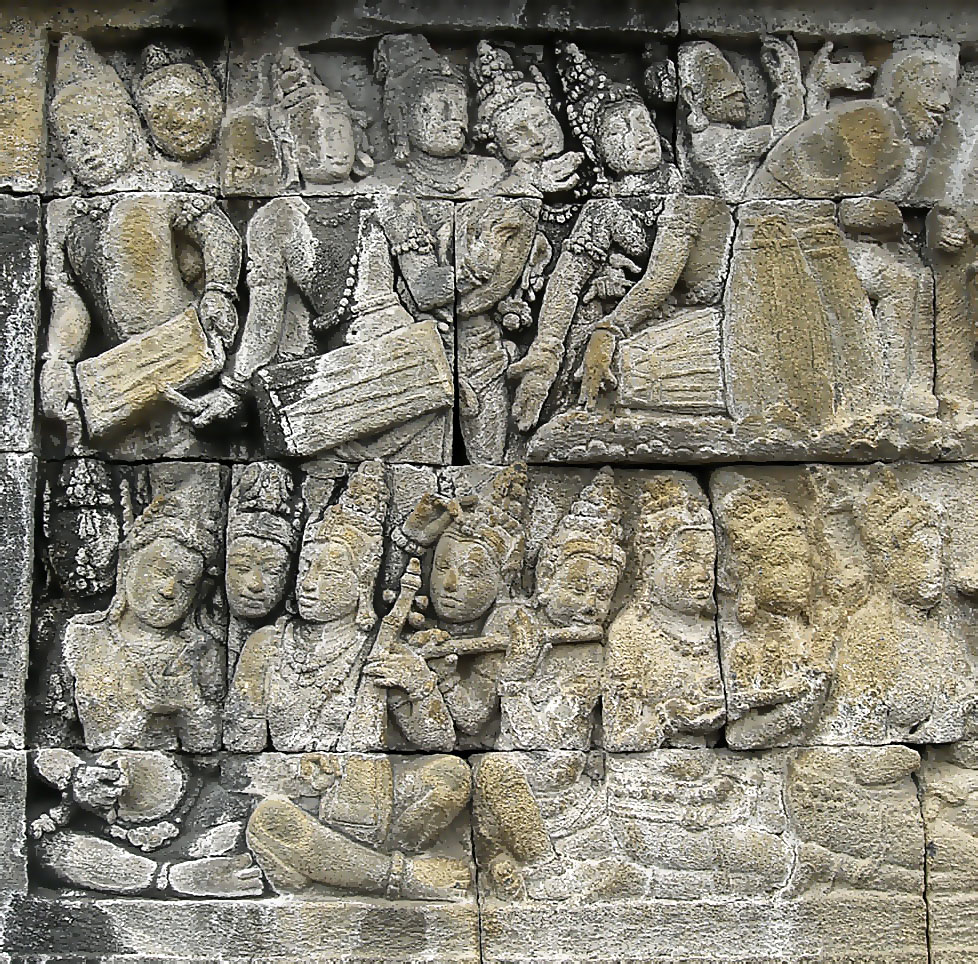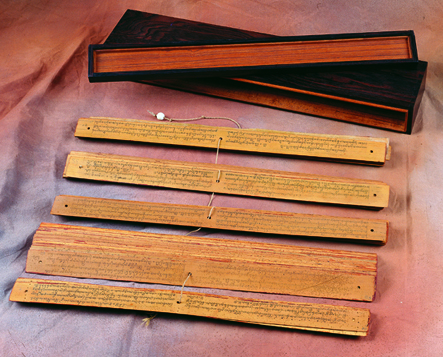|
Cengkok
Céngkok () (old orthography: ''tjengkok'') are patterns played by the elaborating instruments used in Indonesian Javanese gamelan. They are melodic formula that lead to a '' sèlèh'',Brinner, Benjamin (2008). ''Music in Central Java'', p.157. . following the rules of the ''pathet'' of the piece. The most elaborate ''cengkok'' repertoire is that of the '' gendér barung''. The '' gambang'' and '' siter'', on the other hand, do not have such formalized sets of ''cengkok'', and therefore may vary more from performer to performer. Most ''cengkok'' derive from the vocal repertoire, and many have names that originally came from lyrics, like the well-known " Ayu kuning". They may incorporate pre-existent melodic patterns through a process of centonization. See also * Gamelan * Seleh * Sekaran * Pathet * Music of Indonesia * Music of Java The Music of Java embraces a wide variety of styles, both traditional and contemporary, reflecting the diversity of the island and its leng ... [...More Info...] [...Related Items...] OR: [Wikipedia] [Google] [Baidu] |
Panerusan
The panerusan instruments or elaborating instruments are one of the divisions of instruments used in Indonesian gamelan. Instead of the rhythmic structure provided by the colotomic instruments, and the core melody of the balungan instruments, the panerusan instruments play variations on the balungan. They are usually the most difficult instruments to learn in the gamelan, but provide the most opportunity for improvisation and creativity in the performer. Hood, Mantle. ''The Nuclear Theme as a Determinant of Patet in Javanese Music''. New York: Da Capo, 1977. Pages 11–12. Panerusan instruments include the gendér, suling, rebab, siter/ celempung, bonang, and gambang. The female singer, the pesindhen, is also often included, as she sings in a similar fashion to the instrumental techniques. As these include the only wind instruments, string instruments, and wooden percussion instruments found in the gamelan, they provide a timbre which stands out from most of the gamelan. ... [...More Info...] [...Related Items...] OR: [Wikipedia] [Google] [Baidu] |
Pathet
Pathet (, also patet) is an organizing concept in central Javanese gamelan music in Indonesia. It is a system of tonal hierarchies in which some notes are emphasized more than others. The word means '"to damp, or to restrain from" in Javanese. ''Pathet'' is "a limitation on the player's choice of variation, so that while in one ''pathet'' a certain note may be prominent, in another it must be avoided, or used only for special effect. Awareness of such limitations, and exploration of variation within them reflects a basic philosophical aim of gamelan music, and indeed all art in central Java, namely, the restraint and refinement of one's own behaviour." Javanese often give poetic explanations of pathet, such as "Pathet is the couch or bed of a melody." In essence, a pathet indicates which notes are stressed in the melody, especially at the end of phrases ( seleh), as well as determines which elaborations ( cengkok and sekaran) are appropriate. In many cases, however, pieces a ... [...More Info...] [...Related Items...] OR: [Wikipedia] [Google] [Baidu] |
Sekaran
The panerusan instruments or elaborating instruments are one of the divisions of instruments used in Indonesian gamelan. Instead of the rhythmic structure provided by the colotomic instruments, and the core melody of the balungan instruments, the panerusan instruments play variations on the balungan. They are usually the most difficult instruments to learn in the gamelan, but provide the most opportunity for improvisation and creativity in the performer. Hood, Mantle. ''The Nuclear Theme as a Determinant of Patet in Javanese Music''. New York: Da Capo, 1977. Pages 11–12. Panerusan instruments include the gendér, suling, rebab, siter/ celempung, bonang, and gambang. The female singer, the pesindhen, is also often included, as she sings in a similar fashion to the instrumental techniques. As these include the only wind instruments, string instruments, and wooden percussion instruments found in the gamelan, they provide a timbre which stands out from most of the gamelan. ... [...More Info...] [...Related Items...] OR: [Wikipedia] [Google] [Baidu] |
Gamelan
Gamelan (; ; , ; ) is the traditional musical ensemble, ensemble music of the Javanese people, Javanese, Sundanese people, Sundanese, and Balinese people, Balinese peoples of Indonesia, made up predominantly of percussion instrument, percussive instruments. The most common instruments used are metallophones (played with mallets) and a set of hand-drums called ''kendang'', which keep the beat (music), beat. The ''kemanak'', a banana-shaped idiophone, and the ''gangsa'', another metallophone, are also commonly used gamelan Musical instrument, instruments on Bali. Other notable instruments include xylophones, bamboo flutes (similar to the Indian ''bansuri''), a bowed string instrument called a ''rebab'' (somewhat similar to the ''gadulka'' of Bulgaria), and a zither-like instrument called a ''siter'', used in Javanese gamelan. Additionally, vocalists may be featured, being referred to as ''sindhen'' for females or ''gerong'' for males.Sumarsam (1998)''Introduction to Javanese ... [...More Info...] [...Related Items...] OR: [Wikipedia] [Google] [Baidu] |
Gamelan Theory
Gamelan (; ; , ; ) is the traditional ensemble music of the Javanese, Sundanese, and Balinese peoples of Indonesia, made up predominantly of percussive instruments. The most common instruments used are metallophones (played with mallets) and a set of hand-drums called ''kendang'', which keep the beat. The '' kemanak'', a banana-shaped idiophone, and the '' gangsa'', another metallophone, are also commonly used gamelan instruments on Bali. Other notable instruments include xylophones, bamboo flutes (similar to the Indian '' bansuri''), a bowed string instrument called a '' rebab'' (somewhat similar to the '' gadulka'' of Bulgaria), and a zither-like instrument called a '' siter'', used in Javanese gamelan. Additionally, vocalists may be featured, being referred to as '' sindhen'' for females or '' gerong'' for males.Sumarsam (1998)''Introduction to Javanese Gamelan''. Middletown. Although the popularity of gamelan has declined slightly since the introduction of ... [...More Info...] [...Related Items...] OR: [Wikipedia] [Google] [Baidu] |
Gamelan
Gamelan (; ; , ; ) is the traditional musical ensemble, ensemble music of the Javanese people, Javanese, Sundanese people, Sundanese, and Balinese people, Balinese peoples of Indonesia, made up predominantly of percussion instrument, percussive instruments. The most common instruments used are metallophones (played with mallets) and a set of hand-drums called ''kendang'', which keep the beat (music), beat. The ''kemanak'', a banana-shaped idiophone, and the ''gangsa'', another metallophone, are also commonly used gamelan Musical instrument, instruments on Bali. Other notable instruments include xylophones, bamboo flutes (similar to the Indian ''bansuri''), a bowed string instrument called a ''rebab'' (somewhat similar to the ''gadulka'' of Bulgaria), and a zither-like instrument called a ''siter'', used in Javanese gamelan. Additionally, vocalists may be featured, being referred to as ''sindhen'' for females or ''gerong'' for males.Sumarsam (1998)''Introduction to Javanese ... [...More Info...] [...Related Items...] OR: [Wikipedia] [Google] [Baidu] |
Seleh
The ''sèlèh'' note or ''nada seleh'' is an Indonesian music concept used in Javanese gamelan music. In Javanese gamelan music, the ''sèlèh'' note or ''nada seleh'' is the final note of a '' gatra'', or four- beat melodic unit. As such it is the note which serves as the goal for all the various strands of the musical texture.Brinner, Benjamin (2008). ''Music in Central Java'', p.60. . See also * Gamelan * kotekan * Gatra * Colotomy * Slendro Slendro () is one of the essential tuning systems used in gamelan instruments that have pentatonic scale (music), scale. Based on Javanese people, Javanese mythology, the Slendro Gamelan tuning system is older than the ''pélog'' tuning system. ... * Music of Indonesia * Music of Java Sources Gamelan theory {{Indonesia-stub ... [...More Info...] [...Related Items...] OR: [Wikipedia] [Google] [Baidu] |
Gambang (instrument)
A gambang, properly called a gambang kayu ('wooden gambang') is a xylophone-like instrument used in Indonesian gamelan and kulintang ensembles. It has wooden bars (''wilah'') in contrast to the metallic ones of the more typical metallophones in a gamelan. A largely obsolete instrument, the gambang gangsa, is a similar instrument made with metal bars. Gambang kayu The bars of the instrument are made of a hardwood, often teak though many other species are used: ironwood (''kayu besi''), '' merbau'' (Borneo teak), jackfruit, ''ramin'', ''rawan'', ''Artocarpus'' species, etc. The bars are mounted on a deep wooden case that serves as a resonator. Instruments typically have 17-21 keys that are easily removed, and are kept in place by having a hole through which a nail is placed. Generally a full gamelan has two sets, one gambang pelog and the other one gambang slendro. A pair of long thin mallets (''tabuh''), made of flexible water buffalo horn tipped with felt, are used to play the ... [...More Info...] [...Related Items...] OR: [Wikipedia] [Google] [Baidu] |
Music Of Indonesia
Indonesia is a country with many different tribes and ethnic groups, and its music is also very diverse, coming in hundreds of different forms and styles. Every region has its own culture and art, and as a result traditional music from area to area also uniquely differs from one another. For example, each traditional type of music is often accompanied by its very own dance and theatre. Contemporary music scene have also been heavily shaped by various foreign influences, such as America, Britain, Japan, Korea, and India. The music of Java, Sumatra, Bali, Flores (Lesser Sunda Islands) and other islands have been well documented and recorded, and further research by Indonesian and international scholars is also ongoing. The music in Indonesia predates historical records, various Native Indonesian tribes often incorporate chants and songs accompanied with musical instruments in their rituals. The contemporary music of Indonesia today is also popular amongst neighbouring countries ... [...More Info...] [...Related Items...] OR: [Wikipedia] [Google] [Baidu] |
Lyrics
Lyrics are words that make up a song, usually consisting of verses and choruses. The writer of lyrics is a lyricist. The words to an extended musical composition such as an opera are, however, usually known as a "libretto" and their writer, as a " librettist". Rap songs and grime contain rap lyrics (often with a variation of rhyming words) that are meant to be spoken rhythmically rather than sung. The meaning of lyrics can either be explicit or implicit. Some lyrics are abstract, almost unintelligible, and, in such cases, their explication emphasizes form, articulation, meter, and symmetry of expression. Etymology The word ''lyric'' derives via Latin ' from the Greek ('), the adjectival form of '' lyre''. It first appeared in English in the mid-16th century in reference to the Earl of Surrey's translations of Petrarch and to his own sonnets. Greek lyric poetry had been defined by the manner in which it was sung accompanied by the lyre or cithara, as opposed t ... [...More Info...] [...Related Items...] OR: [Wikipedia] [Google] [Baidu] |



